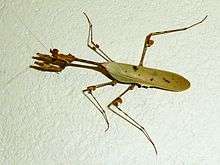Sibylla pretiosa
| Sibylla pretiosa | |
|---|---|
 | |
| Scientific classification | |
| Kingdom: | Animalia |
| Phylum: | Arthropoda |
| Class: | Insecta |
| Order: | Mantodea |
| Family: | Sibyllidae |
| Genus: | Sibylla |
| Species: | S. pretiosa |
| Binomial name | |
| Sibylla pretiosa | |
The cryptic mantis (Sibylla pretiosa) is a species of mantis found in southern Africa.[1] They grow to about 45 mm in length, and have a long and thin prothorax.[1] The distinctively ornamented species has projections on the head, prothorax and four femurs. They live on tree bark in woodlands.
Description
They have unusual leaf-like femoral projections near the joints of their four walking legs. Adults are distinguished from most other mantis species by their leaf-like wings, generally the only green portion of the mantis's otherwise brown and mottled exoskeleton. The spines on the raptorial forelimbs are long and needle-like, compared to the fine comb appearance of species such as Hymenopus coronatus, the orchid mantis. The thorax of the cryptic mantis is very thin and elongated, similar to that of the wandering violin mantis, Gongylus gongylodes. Adult females generally reach 5–6 cm (2.0–2.4 in) in length while the males are generally about 1 cm (0.4 in) smaller. The lifespan of the wild cryptic mantis is unknown, but they have been known to live up to nine months in captivity (wild mantises likely live slightly longer, a year and a few months).
Feeding habits
The mantis almost exclusively eats flying prey, with Drosophila melanogaster fruit flies being the food of preference for young nymphs in captivity. Adults and fifth or sixth instar nymphs can tackle much larger prey, such as house flies, small bees and moths.
References
External links
 Media related to Sibylla pretiosa at Wikimedia Commons
Media related to Sibylla pretiosa at Wikimedia Commons